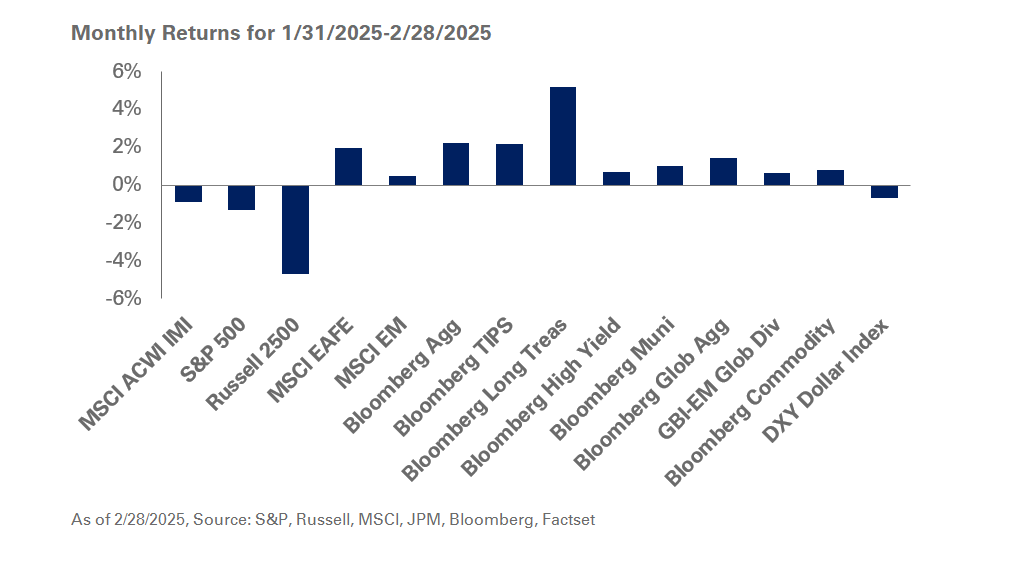In this blog, the second in a series, we continue to follow the decision-making process of a corporate employer—an NEPC client—that has decided to terminate its defined benefit plan, by the end of 2021, through an annuity buyout to an insurer. To ready the plan for sale, contributions were approved each year until termination to facilitate getting the plan to full funding.
THE CHALLENGE
As the plan sponsor continues its path towards plan termination, it is essential to construct a de-risking strategy durable enough to withstand the impact of heightened market volatility unleashed by the COVID-19 outbreak.
To be sure, an efficient de-risking approach will vary by sponsor, asset-allocation strategy, the financial strength of the employer and strategic objectives. That said, we can attest to the effectiveness of well-constructed pension de-risking strategies in limiting volatility in this stressful environment. We would also emphasize the importance of developing and adhering to a thoughtful de-risking plan that aligns time horizon, risk tolerance and liquidity needs to the plan sponsor’s objectives.
The (Updated) Facts
| As of June 30, 2020 | |
| Plan Assets | $718 million |
| Plan Funded Status | 80% |
| Return-Seeking Allocation | 32% |
| Liability Hedging Allocation | 68% |
NEPC’s Role
A significant amount of activity was required to move the client’s return-seeking allocation since our initial post:
- Private-markets portfolio liquidation: We conducted a review process of secondary sales advisors. Upon selecting a winner, a series of calls were conducted with the client, NEPC and the secondary advisor to establish objectives and a timeline, and to review the portfolio and move towards liquidation. We encourage plan sponsors to begin this process early to meet the intended timeline for plan termination. The process can take up to nine months or more, depending on the size and complexity of the portfolio. Discounts to net-asset-values of about 10% to 15% were taken on most plan holdings, with some funds outperforming or underperforming that level based on buyer interest.
- Simplifying the portfolio: With the least liquid holdings now out of the portfolio, a plan was developed to liquidate positions with over 10 managers with varying terms of liquidity within public-market equities and fixed income. These assets were consolidated into low-cost index funds to allow for ease of implementing the glidepath. Subsequently, the return-seeking allocation was significantly reduced as the plan progressed on the glidepath.
- Opportunistic rebalancing: The significant volatility from COVID-19 created relative-value opportunities for plans focused on hedging liabilities. The client’s liability-hedging instruments include Treasury STRIPS (Separate Trading of Registered Interest and Principal of Securities) and long credit. With the significant decline in interest rates and widening of credit spreads, NEPC recommended reducing STRIPS to target and adding more long credit to take advantage of the wider spreads. The client’s lead liability-hedging manager was able to accommodate the move while maintaining the interest-rate-hedge ratio target.
- Increased communication: We upped the frequency of staff and committee communications and continue to provide real time market and plan funded status updates as COVID-19 unfolded. The client recently reaffirmed its ability to meet the estimated terminal contribution and continue with the de-risking process.
At NEPC, we recognize the need for every plan sponsor to fulfil its fiduciary duties related to all aspects of a plan’s management, including annuitization. While many sponsors use their actuary for the entire annuitization process, other resources are available. NEPC conducted a search for independent annuity-placement firms and identified three that our clients could consider, alongside the actuary, when preparing to transfer risk from pension plans.
What’s Next?
Watch this space for further updates. Yet to come: details around further consolidation of investments and a customized liability hedge as the client moves towards plan termination.
Please contact your NEPC consultant if you have any questions or would like to discuss your individual plan.



